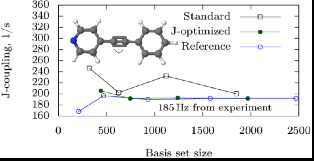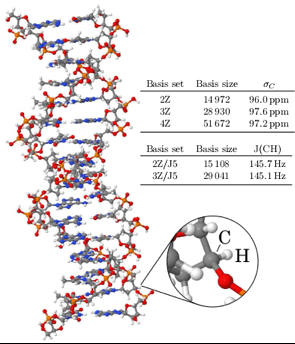Reports: ND655835-ND6: Coupling the Dynamics of Molecules and Spins in Nuclear Magnetic Resonance for Imaging and Oil Borehole Applications
Volker Blum, Dr., Duke University
Warren Warren, Duke University
Our project aims to establish a complete simulation tool chain, which calculates spin coupling and spin relaxation observables in nuclear magnetic resonance (NMR) from first principles, relevant to key problems in oil borehole NMR and in hyperpolarized NMR.
In the second reporting period, we focused on the following objectives:
Objective 1: All-electron implementation of NMR parameters
We have extended our implementation of NMR shieldings and molecular magnetizabilities to include the formalism of gauge including atomic orbitals (GIAOs), using numeric atom-centered orbital (NAO) basis sets and density-functional theory (DFT) as implemented in the FHI-aims code as the basic framework. The GIAO formalism improves the rate of basis set convergence of the shieldings and magnetizabilities, which is especially beneficial for large molecules. GIAO calculations are now possible with semilocal exchange-correlation (xc) functionals such as the commonly used PBE parameterization, in addition to local functionals. For hybrid density functionals, GIAOs would require further modifications to the exchange operator, which we will address in future work. In contrast, our implementation of J-couplings, for which the GIAOs are not necessary and which are more strongly dependent on the xc functional, also works with hybrid functionals in addition to local and semilocal functionals. We found that the standard general-purpose basis sets used in FHI-aims could be amended in order to facilitate accurate calculations of J-couplings. The reason lies in the very localized nature of the perturbation behind J-couplings (specifically, the so-called Fermi contact operator), which requires extreme flexibility of the basis sets in the atomic core region. Building on earlier work done by Jensen (J. Chem. Theory Comput., 2006, 2, pp 1360-1369), we have thus developed a new type of numeric atom-centered orbital basis sets, called NAO-J-n, which have very good convergence properties in terms of the basis set size (Fig 1). The basis sets are available for most elements from H to Cl. Overall, we have demonstrated that the NAO basis sets employed in FHI-aims show better accuracy or are on par with the most accurate Gaussian type orbitals (GTOs) for the calculation of shieldings, J-couplings, and magnetizabilities. The computational time for our NAO implementation scales close to linearly with system size for all numerical parts of the problem except for the algebraic eigenvalue problem that arises in DFT. The latter scales as O(N3). However, this part only becomes dominant for system sizes of a few thousand atoms and above. For this part, we leveraged synergy with a different, NSF-funded project "ELSI" (http://elsi-interchange.org), which focuses on large-scale solution strategy for the general eigenvalue problem in DFT. In addition, by porting over parallel distribution and memory parallelization strategies employed in FHI-aims for numerical integrations, we have demonstrated the capability of calculating high-accuracy NMR parameters for molecular systems of more than 1,000 atoms (Fig. 2) using our new implementation.
Inclusion of scalar relativistic effects and generalization to periodic systems remain ongoing work.
Figure 1. Basis set convergence study of the C-C J-coupling in 4-(2-Phenylethynyl)pyridine (PPA) using the standard (NAO-VCC-nZ) and J-optimized (NAO-J-n) basis sets in comparison to the reference (pcJ-n) values. PPA is a typical example demonstrating the improved convergence of the newly developed NAO-J-n basis sets.
Figure 2. Convergence of basis set size of the NMR shielding and J-coupling in a DNA segment of 1052 atoms. nZ is short for NAO-VCC-nZ, a type of general-purpose NAO basis sets used in FHI-aims. For the J-coupling, the C and H atoms use the NAO-J-5 basis sets, which have been specifically optimized for the calculation of J-couplings.
Objective 2: All-electron simulations did significantly advance the experimental implementations for the hyperpolarization of long-lived states:
In the Warren and Theis lab’s we used the theoretical predictions obtained from the FHI-aims code to characterize and understand hyperpolarization transfer mechanisms into long-lived nuclear spin states. This work was published in J. Phys. Chem. Lett. under the title "Long-Lived 13C2 Nuclear Spin States Hyperpolarized by Parahydrogen in Reversible Exchange at Micro-Tesla Fields" (Zhou et al. J. Phys. Chem. Lett., 2017, 8 (13), pp 3008–3014). This work builds on our 2016 publication funded by this grant in Science Advances ("Direct and Cost-Efficient Hyperpolarization of Long-lived Nuclear Spin States on Universal 15N2-Diazirine Molecular Tags" Theis et al Sci. Adv. (2016) 2 : e1501438.). The new work presented in J. Phys. Chem. Lett. presents a significant advance over the work published in Sci. Adv. because it translates the concept of long-lived hyperpolarized spin states from 15N to 13C, which is the primary nucleus of interest in clinical applications of hyperpolarized magnetic resonance. Specifically, the developed FHI-aims additions for NMR parameters were used to perform unequivocal spectral assignment in the experimental spectra, ultimately revealing the nature of the employed hyperpolarization transfer catalysts (please see the JPCL publication for full details, DOI: 10.1021/acs.jpclett.7b00987).
Project impact on the PI and their teams
In the Blum group, Dr. Raul Laasner, who is the lead developer of the NMR module of FHI-aims, has presented the work at the ENC‘17 (Experimental NMR Conference) and SMASH’17 (Small Molecule NMR) conferences. For the latter, a scholarship was awarded to support the participation at the conference. A theoretical paper detailing the implementation of the NMR calculations is currently in progress. PI Blum received tenure at Duke University effective July 1, 2017; the present project is an essential part of his continued investment in the area of molecular spectroscopy.
In the Warren lab, now Professor Theis was able to establish himself as a group leader in the Duke Center for Molecular and Biomolecular Imaging thanks to this grant. Prof. Theis oversaw the experimental design and coordinated the collaboration with the Blum lab. Post-doctoral researcher Johannes Colell conducted many of the experiments, but also helped with the ab-initio calculations in collaboration with Raul Laasner (post-doc in the Blum lab). The student, Zijian Zhou and post-doc Johannes Colell were given the opportunity to present the JPCL work at the ENC‘17 (Experimental NMR Conference) and Theis presented the work at various conferences including the ISMRM 2017 (US), ISMAR 2017 (Canada) and SCM 2017 (Germany).













